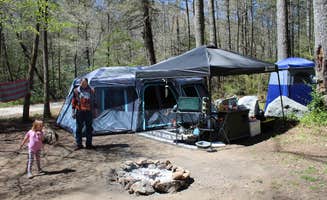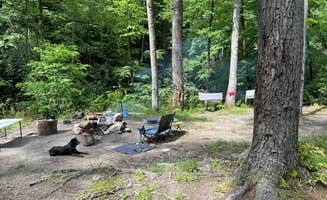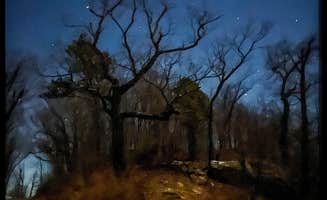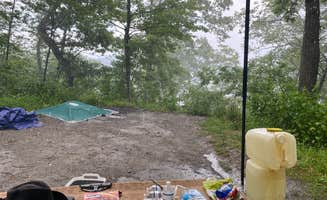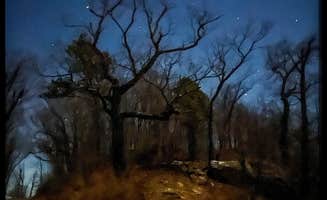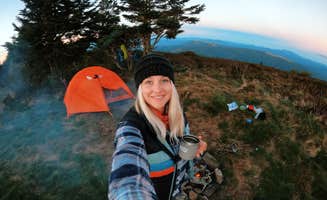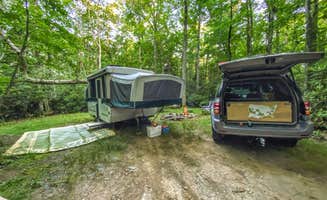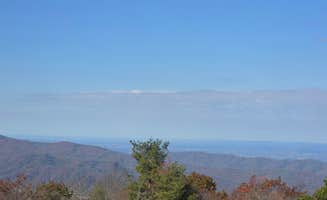Dispersed camping near Collettsville, North Carolina ranges from 2,500 to 6,000 feet in elevation across the surrounding Pisgah National Forest terrain. The area receives approximately 54 inches of annual rainfall, creating lush forests and active creek systems throughout the camping corridors. Spring camping brings average temperatures of 45-70°F with frequent afternoon thunderstorms, while fall offers drier conditions with temperatures between 40-65°F.
What to do
Swimming in Upper Creek pools: Several swimming spots with small waterfalls are accessible along the 2-mile forest service road. "A two mile long gravel road that parallels with a beautiful river with a bunch of pull offs to camp or hangout at," notes a visitor to Upper Creek, Pisgah National Forest NC. The creek offers natural swimming holes of varying depths.
Hiking to Linville Falls: Located approximately 15 minutes from many campsites, these trails range from easy 0.5-mile paths to more challenging 1.4-mile descents into the gorge. "We hiked down to the gorge and also enjoyed the dispersed camping available right along the riverside, which was pretty cool but... that hike back up is a DOOZY especially with a pack on," explains a camper at Linville Gorge Wilderness Dispersed Camping.
Trout fishing in season: The Linville River offers rainbow and speckled trout fishing opportunities with restrictions. "You may also be able to trout fish in Linville River if it's trout season and you're licensed. Speckled and Rainbow trout are beautiful in this area. Most fall within the 8-12 inch range. Check bait restrictions. It's almost always no live bait allowed when we've camped there," advises a regular visitor.
What campers like
Secluded creek-side spots: The sound of flowing water creates natural white noise for sleeping. "Spent two nights here at a site right next to the creek, which was awesome listening to the running water as you fall asleep," mentions a camper at Steele Creek. These creek-adjacent sites are among the most sought-after in the region.
Views of Table Rock Mountain: Multiple sites along the ridgelines offer direct sightlines to this distinctive landmark. "If you take your time and they are available there are a few spots on both sides of the road with wonderful views," notes a camper at Old NC 105 - Dispersed Camping. The most panoramic views are typically found in the first 3-4 miles of the forest service road.
Abundant campfire wood: Many campsites have plentiful downed wood for campfires. "The ground wood for campfires is very abundant and many of the sites are appropriate for groups," mentions a visitor. Sites farther from main roads tend to have more available firewood due to less frequent use.
What you should know
Limited cell service: Coverage varies significantly by location and provider. "We had decent cell service," notes one camper at Old NC 105 Dispersed, while others report no signal in creek bottoms and deeper valleys. Verizon generally performs better than other carriers in the region.
Weekend crowding: Popular sites fill quickly on Friday afternoons. "We drove up on a Saturday and it wasn't too crowded, definitely people around but plenty of open campsites," shares one camper. During summer months, arriving before 2pm on Fridays significantly increases chances of securing preferred sites.
Road conditions vary seasonally: Heavy rains create challenging access points. "The road was in good shape but steep narrow and lots of switch backs but well worth it," reports a camper. Spring thaw (March-April) and heavy summer thunderstorms can create washouts on unpaved roads leading to campsites.
Tips for camping with families
Best kid-friendly spots: Look for sites with gradual creek access and level terrain. "There are multiple sites along the service road and not too close to each other," notes a camper at National Forest Road/Steele Creek/Nates Place. Sites farther from road edges provide better safety for younger children.
Tick and mosquito management: Insect activity increases significantly in warmer months. "I did get eaten alive by mosquitos and I found a tick on my chair so be on the lookout," warns a camper. Ticks are most active April through October, with peak activity in June and July when nymphs are prevalent.
Water filtration needs: No potable water exists at any dispersed sites. "Biggest con for me is I use a pump filter to fill up water no camp sight that I could find had access to the river that runs along this road so make sure to bring plenty of bottled water," advises an experienced camper. Plan for 1-2 gallons per person per day depending on weather conditions.
Tips from RVers
Limited RV accessibility: Most sites accommodate small trailers or vans at best. "Maybe I missed this in the reviews, but all but 1 site were best for tents. I drove in to camp in my car and there was only 1 spot, which is by the creek crossing, and it was already taken," notes a visitor to Steele Creek. The most accessible RV spots are within the first mile of forest roads.
Width constraints: Forest roads have narrow passages with limited turning radius. "Great place by Blue Ridge Pkwy. Not very far off Pkwy, we had no problem getting there with our Artic Fox truck camper and pulling a Jeep," reports a camper at Victor Road Dispersed. Most forest roads range from 8-12 feet wide with occasional wider pullouts.
Leveling challenges: Few sites offer naturally level parking. "There are pull-in spots for cars and vans next to the road, several with great views of the valley and gorge. Only downsides are good view sites right on the road, and hard to find level ground," observes a camper. Bring adequate leveling blocks as elevation changes can exceed 6-8 inches across typical parking areas.


